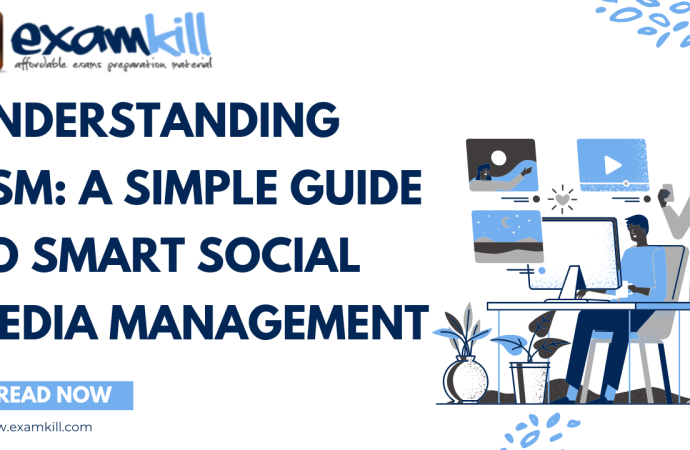Introduction Social media is everywhere today. Whether it’s Facebook Instagram or TikTok people spend hours online every day. That’s where SSM Social Media Management comes in. It helps you handle your social accounts easily reach more people and grow your brand. Let’s explore what SSM really means and how you can use it to your advantage. In
Introduction
Social media is everywhere today. Whether it’s Facebook Instagram or TikTok people spend hours online every day. That’s where SSM Social Media Management comes in. It helps you handle your social accounts easily reach more people and grow your brand. Let’s explore what SSM really means and how you can use it to your advantage.
In today’s digital world, social media is more than just a place to share photos or updates. It has become a powerful tool for businesses, influencers, and individuals to connect with audiences worldwide. However, managing social media effectively can be challenging. That’s where Smart Social Media Management, or SSM, comes in. SSM is a method that helps you plan, create, and monitor content across social platforms efficiently. This guide will explain what SSM is, why it matters, and how you can use it to improve your online presence.
What is SSM?
SSM stands for Social Media Management. It’s all about planning posting and analyzing your content on social media platforms. Think of it as a smart way to organize your online presence.
With SSM you can decide what to post when to post and how to connect with your audience. It’s not just about uploading random pictures or videos it’s about creating a clear plan that fits your goals.
For example imagine you run a small bakery. With SSM you can plan weekly posts about new cakes respond to customer comments and see which posts get more likes. This helps you understand what people love and what you should do more often.
Smart Social Media Management is a strategic approach to handling social media accounts. Instead of posting randomly or reacting to trends, SSM involves planning content, scheduling posts, analyzing performance, and interacting with followers in a structured way.
The goal of SSM is to save time while maximizing impact. It combines creativity with data-driven decisions, ensuring that every post, comment, or campaign contributes to your overall objectives. By using SSM, businesses and individuals can grow their audience, improve engagement, and strengthen their brand online.
Why Smart Social Media Management Matters
Many people think social media is simple, but managing multiple platforms effectively requires strategy. Here are some reasons why SSM is important:
- Consistency: Posting regularly keeps your audience engaged and improves brand visibility.
- Better Engagement: SSM helps you understand what your followers like and interact with content they enjoy.
- Time-Saving: Planning and scheduling posts in advance reduces stress and prevents last-minute rushes.
- Data-Driven Decisions: Monitoring performance allows you to adjust strategies based on what works best.
- Professional Image: Well-managed accounts show that your brand is organized and trustworthy.
Using SSM ensures that your social media presence is effective and contributes to your overall goals, whether it’s growing your business, promoting products, or building a personal brand.
How SSM Works
You might wonder “How does SSM actually work?” Let’s break it down stepby step:
Step 1: Set Clear Goals
First decide what you want from social media. Do you want to increase followers drive sales or just share updates? Knowing your goal helps you create better content.
Step 2: Choose the Right Platforms
Not every platform fits every brand. If your audience loves visuals go for Instagram. For professionals LinkedIn works best. Pick where your audience spends time.
Step 3: Create a Content Plan
Plan your posts in advance. Include photos videos quotes and even behind the scenes moments. A monthly calendar helps keep things organized.
Step 4: Schedule Posts
Use SSM tools like Buffer or Hootsuite to schedule your content. This saves time and ensures your posts go live even when you’re busy.
Step 5: Engage with Followers
Don’t just post and disappear. Reply to comments like posts and thank your followers. People love real interaction.
Step 6: Analyze Results
Check insights or analytics every week. See which posts perform best and which ones need improvement. Then adjust your plan.
That’s how simple and smart SSM can be when done the right way.
Key Components of Smart Social Media Management
SSM involves several important components that work together to create a strong social media strategy.
1. Planning and Strategy
Before posting anything, it’s essential to plan your content. This includes:
- Defining your target audience
- Choosing the right platforms
- Setting goals for engagement, sales, or awareness
- Creating a content calendar
Planning ensures that your posts are relevant and timely, which helps your audience stay connected and engaged.
2. Content Creation
Content is the heart of social media. SSM encourages creating high-quality, engaging content, such as:
- Images and graphics
- Short videos or reels
- Infographics
- Blog links or informative posts
- Polls, quizzes, and interactive content
The key is to mix different types of content to keep your audience interested.
3. Scheduling Posts
Posting at the right time can significantly improve engagement. Smart Social Media Management uses scheduling tools to:
- Post consistently without missing days
- Reach audiences when they are most active
- Save time for other important tasks
Popular tools include Buffer, Hootsuite, and Later, which allow you to schedule posts across multiple platforms at once.
4. Monitoring and Engagement
Posting content is not enough; engagement is crucial. SSM emphasizes:
- Responding to comments and messages promptly
- Interacting with followers through likes, shares, and replies
- Monitoring mentions and brand tags
Engaging with your audience builds trust and loyalty, making them more likely to support your brand.
5. Analytics and Optimization
One of the most important aspects of SSM is analyzing results. This involves:
- Tracking likes, shares, comments, and impressions
- Monitoring follower growth and retention
- Measuring website clicks or sales from social media
By understanding which posts perform best, you can refine your strategy and focus on content that delivers results.
Benefits of Using SSM Tools
SSM tools make social media management easier and more efficient. Here are some benefits:
- Centralized Management: Handle all platforms from a single dashboard
- Time Efficiency: Schedule posts ahead of time and automate repetitive tasks
- Insights and Reporting: Access detailed analytics to guide your strategy
- Team Collaboration: Multiple team members can work together on content creation and posting
- Audience Targeting: Some tools allow targeting specific demographics for better results
Using SSM tools ensures that your social media efforts are organized, efficient, and data-driven.
Common Mistakes to Avoid in SSM
Even with the best tools many people make simple mistakes when managing social media. Avoid these if you want good results:
- Posting Without a Plan: Random posting confuses your audience. Always have a strategy.
- Ignoring Analytics: Don’t skip checking what’s working. Data helps you grow.
- Overposting: Too many posts can annoy followers. Focus on quality not quantity.
- No Engagement: Ignoring messages or comments makes you look inactive.
- Copying Others: Stay unique. Your audience wants your style not someone else’s.
Practical Tips to Master SSM
Here are a few easy and effective ways to get better atSSMevery day:
- Stay Consistent: Post regularly but don’t overwhelm your audience.
- Use SSM Tools: Apps like Buffer Hootsuite or Later can make your work faster.
- Plan Content Themes: Pick weekly themes like Motivation Monday or Feature Friday.
- Follow Trends: Keep an eye on trending hashtags and join them in your way.
- Be Real: Show your personality. People connect with real stories and emotions.
- Keep Learning: Social media changes fast. Keep reading and trying new ideas.
For instance I once helped a friend manage their small clothing page. At first we posted randomly. After using an SSM plan engagement doubled in two weeks. That’s the power of being organized.
In today’s world SSMisn’t just an option it’s a must. Whether you’re a student a small business owner or part of a big company learning how to manage social media effectively can make a big difference. Start small plan your posts reply to your followers and track your results. With consistent effort and smart SSM practices your online presence will grow naturally. So why wait? Try using an SSM tool today and see how much easier social media becomes!
SSM for Businesses and Individuals
SSM is not just for big businesses; it is valuable for individuals, small businesses, influencers, and non-profits.
- Businesses: Use SSM to promote products, announce sales, and connect with customers.
- Influencers: Build personal brands by posting consistent, high-quality content.
- Non-Profits: Share campaigns, updates, and stories to engage supporters.
- Freelancers: Showcase skills, connect with clients, and grow professional presence online.
The principles of planning, engagement, and analytics apply to anyone who wants to make the most of their social media efforts.
Conclusion
Smart Social Media Management, or SSM, is an essential strategy for anyone looking to succeed in today’s digital landscape. By planning content, creating engaging posts, scheduling effectively, and analyzing performance, SSM helps individuals and businesses maximize their social media impact. It saves time, improves engagement, and builds a professional online presence.
Whether you are a business owner, influencer, or freelancer, understanding and implementing SSM can transform the way you use social media. By avoiding common mistakes and using tools effectively, you can grow your audience, strengthen your brand, and achieve meaningful results online. Smart Social Media Management is more than just posting—it’s about working smarter, not harder, to make the most of your social media presence.
FAQs
Q1. What does SSM mean?
SSM stands for Social Media Management which helps organize schedule and track your social media activities.
Q2. Why is SSM important for businesses?
It saves time improves consistency and helps build stronger connections with your audience.
Q3. What tools are used in SSM?
Popular tools include Buffer Hootsuite and Later for scheduling and analytics.
Q4. Can beginners use SSM easily?
Yes SSM tools are simple to use even for beginners. Many offer free plans to start with.
Q5. How often should I post using SSM?
It depends on your audience but 3-5 times a week is usually a good balance.
















